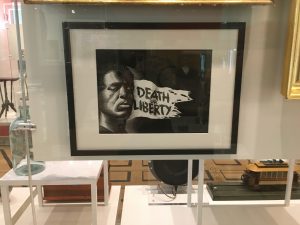By Benjamin Pomerantz
A few weeks ago, I visited The Valentine, a museum in the city of Richmond that focuses on telling the story of Richmond’s history. Now, to be clear, there are many ways and many perspectives from which to develop a historical narrative–from the white Confederate point of view, from the enslaved point of view, from the free black point of view, from the immigrant point of view, etc. Based on my experience, I thought that the curators of The Valentine did their best to make the museum’s narrative of Richmond’s history inclusive of all Richmonders. Instead of focusing on the story of a certain population of Richmond, The Valentine includes many perspectives of Richmond in an attempt to portray Richmond as a diverse city with people of many interacting beliefs, customs, and lifestyles. As someone partnering with Untold RVA, it was exciting to see stories of black self-determination and resistance at a Richmond museum, especially because the city tends to memorialize the legacy of the Confederacy as opposed to the lives of enslaved people and free blacks in Richmond.
The permanent exhibit at The Valentine, located on the main floor of the museum, is a large, square-ish room that did not provide many directions for navigation. Since I was without a tour guide, I spent the visit wandering the various portions of the exhibit. The exhibit is organized in a rather interesting way–instead of featuring sections based on time periods, regions, or populations, the Valentine is organized by question. For example, the “What Do We Produce?” section contained clothes and objects that Richmonders have used throughout the city’s history, and the “What Do We Value?” section explored the many fights for American independence that have occurred in Richmond’s history.
The most provocative section at The Valentine, from my point of view, is the “Who Has a Voice” section. It is in this section that one can find the several aforementioned stories of black self-determination and resistance. It features a portrait of Gabriel, who tried to seize the city of Richmond in order to resist slavery and free himself and other enslaved people from bondage, under a banner which reads “Death or Liberty.”
It also features a portrait of James Armistead Lafayette, a enslaved man who volunteered with the patriot forces during the American Revolution as a spy. This act of self-determination allowed him to gain freedom for himself later in life. By including portraits of Gabriel and James in their exhibit, the curators of The Valentine show that these acts of black resistance and self-determination are important to the city of Richmond’s history. At the same time, it should be noted that there were many types of black self-determination—like teaching others in the black Richmond community to read, establishing churches, and developing businesses, for example—that were largely excluded from the museum’s exhibit.
While my experience at The Valentine was a largely informative one, and while I was genuinely pleased to see several acts of black self-determination and resistance on display, I was a bit disappointed by the lack of information about the lives of enslaved people in Richmond. For a museum that proudly featured stories of enslaved people who fought for their freedom, it largely omitted information about the lives of those enslaved people. This is not to say that the museum doesn’t even touch on the subject of slavery–it features a pair of leg shackles that an enslaved person would have worn, and a mini-section on the slave trade, but it failed to give examples of what went on in the lives of enslaved Richmonders. It also fails to mention slavery in its description of Rockett’s Landing, which used to be a slave port, describing it as “Richmond’s first urban center” but not as a port for the slave trade, the largest one outside of New Orleans. So, while The Valentine tries to tell as many narratives as it can of Richmond’s history, it is important to recognize that the narrative of the enslaved is a key component of the city’s history.
Benjamin Pomerantz is a rising junior majoring in American Studies and minoring in both Rhetoric & Communication Studies and History. This is his first time working with the Race and Racism Project, and he is very happy to be able to join the team for this summer as an A&S Summer Research Fellow.


Excellent review and analysis. Superb writing and clarity. Our next step is to prompt all to learn about, understand, and through empathy live the nightmare of slavery, and recognize its ongoing impact on American society. Thank you for sharing such excellence and explorative leadership.